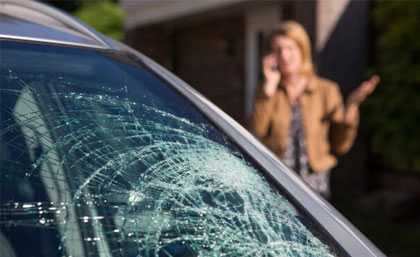The History of Automobiles Safety

The history of automobile safety is a unique combination of driver education efforts, technological advances, and government regulations. Improvements in these areas have made great progress in reducing the number and severity of car accidents in America. Safety advocates, auto manufacturers, and lawmakers continue to work to improve vehicle safety in the United States.
The modern car was created in 1886 by German inventor Karl Benz. (Benz would be famous for introducing the Mercedes automobile in 1901, which would eventually launch the well-known Mercedes-Benz brand.)
Here in America, automobiles were not widely available until Henry Ford introduced his Model T in 1908. Ford’s efficient production practices – like his famous assembly line – reduced the price of his automobiles. This meant many American families were able to enjoy the new freedom that came with vehicle ownership, but the dangers soon became obvious. Throughout the 1910s, speeding, reckless driving, collisions, and pedestrian fatalities were new problems requiring new solutions.
Early Driver Behavior
The National Safety Council was established in 1913. Its mission was to eliminate preventable deaths in the workplace, in homes, and across communities – as well as the emerging problem of preventable deaths on the road. The National Safety Council focused and continues to focus on the human factor in automobile accidents. Other local, state, and federal advocacy groups also campaigned for safety initiatives. Meanwhile, the auto industry searched for specific causes of fatalities by compiling accident reports.
The industry insisted that automobiles themselves did not contribute to accidents if driven properly. This history bears an interesting parallel to the current controversy over self-driving cars. Though several serious accidents have cast doubt on the safety of these autonomous vehicles, many accidents involving them have been caused by driver error in other vehicles on the road. Self-driving cars typically function as they are programmed to perform.
Driver Education — The Motor Cities National Heritage Area reports that driver’s education dates to 1920 when school districts across the country began offering instruction on traffic safety within other course subjects. The first separate driver’s education course was offered in 1927 in Gilbert, Minnesota. In 1933, Amos Neyhart offered a driver’s education course that included road safety instruction. He reported on the success of this program to the National Safety Congress in Chicago. By 1936, a driver’s education course was offered for credit at Pennsylvania State College.
The first driving simulators were first introduced in the 1940s. These offerings further expanded students’ understanding of road safety by offering practical experience in handling traffic scenarios. Budget restrictions eventually forced many school districts to restrict driver’s education courses or eliminate them entirely. Those that did not often simply charged parents for the course. Today, parents can pay $250 or more for driver’s education training. The savings in auto insurance premiums makes this a wise investment for many families. Of course, the most important societal benefit of driver’s education is a reduction in the number of car accidents. A study by AAA found that teens who took driver’s education were 4.3 percent less likely to be involved in an accident. Interestingly, these same teens were a staggering 40 percent less likely to receive a traffic ticket.
Shock Value — Shock value has long been a cornerstone of driver’s education curriculum. This dates back all the way to August 1935, when Reader’s Digest published “–And Sudden Death.” The story was a gritty, graphic description of the realities of car accidents that garnered much attention across the country. It changed the way advocates approached the public relations aspect of automotive safety. For many years, public service announcements and safety campaigns would be centered around shock value.
The more graphic gore and gritty content a story contained, the more attention it was likely to receive. In 1964, the California Highway Patrol joined in the shock value parade with the production of Red Asphalt. This was meant to be an instructional driver’s education video. Due to its graphic description of car accidents and gruesome images, some critics derided the film as “the Reefer Madness of driving: Forget trying to reason with teenagers, just scare them.”
The films’ bad acting did not help this charge. In spite of these criticisms, the California Highway Patrol released Red Asphalt II in 1978, Red Asphalt III in 1989, Red Asphalt V in 1998, and Red Asphalt V in 2006. The Red Asphalt films are a classic example of shock value in a road safety campaign.
Driving Under the Influence — According to The Newswheel, drunk driving laws began in the United States in 1906. That was the year that a New Jersey law first decreed that “no intoxicated person shall drive a motor vehicle.” A violation of this law was punishable by a fine of up to $500 and sixty days in the county jail. This and other early laws required proof of intoxication. Unfortunately, they did not state what level of inebriation was required, which led to uneven enforcement of drunk driving laws. Scientists began tackling the problem of how to test a person for intoxication.
In 1927, Dr. Emil Bogen of Los Angeles conducted a landmark study on the subject. He found that breath could be used as a reliable indicator or BAC. Gizmodo reports that Dr. Bogen’s breath test used a large football bladder that contained sulphuric acid and potassium dichromate. A patient would breathe into it, and as the chemicals in the football bladder changed from yellow to various shades of blue and green, they were compared to tubes of the same chemicals in which different amounts of alcohol had been added. This was a highly scientific process that, while valid, was highly impractical for use by law enforcement working in the field. Other researchers began tackling the problem of creating a BAC test that could be easily used in the field. In 1938, Dr. Rolla Harger had a working prototype of a device that was being tested by the Indiana State Police.
He jokingly called his device the “drunkometer.” Competing devices hit the market in the 1940s. By 1954, Robert Borkenstein – a photographer at the Indiana State Police Lab – had invested the Breathalyzer. This is the predecessor of the most common breath-testing devices used today. Testing devices still left the question of how much alcohol qualified a driver as intoxicated. By 1936, Norway had passed a drunk driving law that set the limit at .05 percent. Indiana was the first state to pass a drunk driving law with BAC requirements in America in 1939. According to the Council of State Governments Midwest, a BAC below .05 percent was not considered intoxication. A BAC of .05 to .15 percent was considered “relevant evidence” in a drunk driving prosecution. And a BAC of .15 or greater was presumed to be intoxication (although this presumption could be rebutted by the defendant). This basic outline is still followed in many state laws today, which still create a rebuttable presumption of intoxication at a specified BAC level. By 1998, all fifty states had passed “Zero Tolerance” laws.
These laws prohibit anyone under the age of 21 from driving with a BAC of .02 grams per deciliter or higher. They are especially important for younger drivers, who are known to have a higher rate of accidents. In 2000, the Department of Transportation Appropriations Act contained a landmark provision to curb drunk driving. The law required states to enact .08 per se laws by 2004 in order to continue receiving federal highway construction funds. These “per se” laws changed the legal standard of “relevant evidence.” Instead, a driver was legally presumed to be intoxicated if his or her BAC was at .08 or above. By 2005 all fifty states, DC, and Puerto Rico had enacted .08 per se drunk driving laws.
Mothers Against Drunk Driving — On May 13, 1980, Cari Lightner was killed by a drunk driver in Fair Oaks, California. Cari, just thirteen years old, was a softball all-star. She and a friend were walking to a church carnival when they were struck by a drunk driver. The driver had only been out of jail two days since his latest DUI (his fourth). He struck Cari so hard that she was thrown out of her shoes and flew 125 feet. The repeat DUI offender fled the scene. He was later caught and charged with causing Cari’s death. Later that year, Cari’s mother Candace Lightner founded Mothers Against Drunk Drivers (later renamed to Mothers Against Drunk Driving). MADD reports that Candace carried her daughter’s picture with her as she worked to change California DUI laws.
To this day, MADD advocates use photos of drunk driving victims to try to put faces to the problem. This has been an effective way to give meaning to the staggering statistics of drunk driving in America. MADD has created local chapters, supported legislation at the state level, helped to establish the constitutionality of sobriety checkpoints, and supported the use of ignition interlock breath analyzers.
MADD has become one of the most powerful lobbying groups for drunk driving legislation, and the effects of its work can be seen in all fifty states. Drunk driving laws are much stronger today than they were in the 1960s and 1970s. This is due in large part to MADD.
“If you’ve been hurt in a an accident, you need legal representation immediately. Call Arash Law today to schedule a free case evaluation with a respected car accident attorney in California.”
Technological Solutions in Automobile Safety
While safety advocates targeted driver behavior, the automotive industry soon realized that vehicles needed safety features. These features could both prevent collisions and reduce the severity of injuries that were sustained in collisions (thus reducing the likelihood that a car accident would be fatal).
Safer Glass — Early cars had plate glass windshields and windows. In a collision, the glass broke into sharp, dagger-like pieces that could injure or kill motorists. The 1926 Stutz sedan was the first vehicle to address this. The manufacturer added horizontal wires in the glass to help control breakage. Later, vehicles had a more effective solution to the problem of shattered windshields with a “sandwich” of glass and celluloid that held fragments together on impact. Triplex glass was standard equipment on the 1928 Ford Model A windshield and attracted attention because it was mass-marketed on a low-priced car. General Motors installed shatterproof Duplate windshield glass on 1930 Cadillac cars. Like Triplex, Duplate consisted of two sheets of glass with an intermediate layer of celluloid. Duplate was made by the Pittsburgh Safety Glass Company, which was owned by Pittsburgh Plate Glass and DuPont. Today, safety glass is used widely in consumer goods. Shower doors and other home products are secured with safety glass to reduce the risk of injury due to shattered glass.
Safety versus Styling — By the 1930s, automobile manufacturers had learned that modern styling attracted new car buyers more than mechanical performance. Streamlined bodies made cars appear to be the cutting edge of machine-age technology and symbols of modernity and speed. Annual model changes and art deco embellishments excited car shoppers with the prospect of owning the newest fashions in mechanical beauty and the latest gadgets. But streamlining often conflicted with safety.
One of the earliest problems drivers learned about was dashboard ornamentation. Knobs, dials, and other dashboard accessories could cause serious injuries in a car accident. Claire Straith, a plastic surgeon, studied the cranial and facial injuries sustained in auto accidents. He advocated for padded dashboards that helped reduce injuries caused by dashboard ornaments. From the 1950s to 1970s, car marketing emphasized horsepower and speed. Some industry officials insisted that powerful engines enhanced safety because motorists could escape dangerous situations quickly. But safety advocates questioned drivers’ ability to handle automobiles at higher speeds. The horsepower race remained a feature of new car marketing through the 1960s. The produced the famous “muscle cars” of the late 1950s, 1960s, and early 1970s.
Early marketing by auto manufacturers focused on the cosmetic improvements made to their vehicles. Looks and style were often emphasized over safety. This has changed over the years. Today, new safety features are routinely the center of ad campaigns for new vehicles. Ultimately, it is still up to consumers to research and choose the features that are most important to them.
Mass-Produced Safety Cars — Robert McNamara, general manager of the Ford Division, believed that manufacturers had a moral obligation to study safety issues, develop protective safety hardware, and educate consumers. He also thought that life protection could sell cars. The National Safety Forum, a two-day conference in 1955 with crash tests and announcements of new safety features on the 1956 cars, was Ford’s attempt to raise the profile of auto safety research and intrigue the public.
Ford launched a major advertising campaign for its Lifeguard Design package on 1956 Ford and Mercury cars. A dish-shaped steering wheel, clustered knobs and instruments, and stronger door latches were standard equipment. At additional cost, motorists could order lap belts, a padded dashboard, padded sun visors, and a shatter-resistant rearview mirror. Sales were brisk at first but soon were outpaced by the 1956 Chevrolet, which sported new styling and optional lap belts, shoulder harnesses, and a padded dashboard.
The modern three-point seat belt was invented by Nils Bohlin, a Swedish engineer working for Volvo. Prior to 1959, most automobiles only had two-point belts that strapped across the abdomen. These routinely caused serious internal injuries to car crash victims. Bohlin was hired by Volvo in 1958 as the result of his work designing ejector seats for Saab airplanes. Within a year, Bohlin had designed the efficient three-point harness that is widely used today. History reports that Volvo made the design available for free to all other auto manufacturers in the interest of public safety. The design was required for all vehicles manufactured in the United States after 1968. At the time of Bohlin’s death in 2002, Volvo estimated that his design had saved over a million lives. The National Highway Traffic Safety Administration estimates that seat belts save more than eleven thousand lives every year in the United States alone. NHTSA also reports that seat belt use hit an all-time high in 2015 at 87 percent.
Airbags — The history of airbags starts with a Sunday afternoon drive into the Pennsylvania countryside in the spring of 1952. Retired industrial engineering technician John Hetrick swerved to avoid a rock in the road, and he and his wife both threw out their hands to prevent their daughter from hitting the unprotected dashboard. Hetrick later recalled wondering why there wasn’t some object to come out and prevent one from striking the inside of the vehicle during a collision. He filed his disclosures that year and was granted a patent in 1953.
According to Consumer Affairs, Allen Breed then made critical safety changes that were implemented into modern airbags. Breed – a mechanical engineer – invented a reliable and affordable crash sensor that could be integrated with the airbag itself. But throughout the 1970s, early airbag prototypes seemed to cause more problems than they solved. Inflated airbags were rigid. Airbags could injure or even kill people of short stature. Children, in particular, were susceptible to airbag injuries. In 1991, Breed patented a design for an airbag that vents air as it inflates. This helped to prevent secondary injuries caused by a rigid airbag. These and other critical safety features are used today in the next generation of airbag technologies.
On September 1, 1998, the Intermodal Surface Transportation Efficiency Act of 1991 went into effect. Among other provisions, this Act required all vehicles sold in the United States to be equipped with airbags on both sides of the front seat. History reports that the risk of dying in a head-on collision has been reduced by 30 percent with airbags. Researchers agree that airbags have saved at least ten thousand lives since the late 1980s. As airbag technologies continue to improve, many more lives will continue to be saved by Hetrick’s original idea.
Child Car Seats — Child car seats are one of the most well-known and widespread ways to prevent children from being injured in car accidents. Today they are common practice for all parents, and this makes it even more disturbing to learn about the history of child car seats. At first, they were nothing more than a burlap sack that hung over the passenger seat. A drawstring allowed parents to secure the bag to the seat and contain the child within the bag. The design was horrifying, but the real problem was that it offered children no protection from the forces of a collision. Subsequent models did little to rectify this problem. In the 1940s, car seats featured a canvas sling over a metal frame.
This merely allowed the child a better view out of the car windows. While the design was less horrifying, it still did nothing to protect a child in a car crash.
By 1971, the National Highway Traffic Safety Administration had finally adopted regulations specific to children. Safe Ride 4 Kids reports that this first rule only required a seatbelt with a harness that could be used to hold the child in the seat. By 1979, Tennessee had enacted the first child car seat law, and by 1985 all fifty states had child car seat laws. But enforcement of these laws was still a problem. Even in 1987, only 80 percent of children used car seats.
Today, after decades of advocacy and law enforcement, child car seat use is more common than ever. But it is still not 100 percent. This is a problem: Safe Ride 4 Kids reports that 57 percent of car accident deaths among children aged 0-15 involved a child who was not restrained. Many of these deaths could have been prevented by the simple use of car seats, booster seats, and seat belts. We still have work to do to keep children safe on the roads of California.
The Next Generation of Safety Features — Most new vehicles sold today have a wide array of new safety features. In 2007, federal legislation required electronic stability control to be installed in all passenger and light-duty vehicles. Tire pressure monitoring systems were also required that year. Backup cameras were required for all vehicles built after April 2018.
Many other features are not yet mandatory but are still critical to saving lives. Front and side cameras can help eliminate a driver’s blind spots. Automatic braking help drivers avoid collisions. Adaptive cruise control monitors the speed of the vehicle ahead of you so your car can automatically slow down and speed up according to road conditions. Lane departure warnings help keep drivers in their own lanes. The new Hyundai Santa Fe has a safety exit assist that prevents back seat passengers from opening their doors when vehicles or bicycles are approaching from behind.
Facial recognition software can identify when a driver is sleepy or not paying attention. All of these features have great potential to improve road safety dramatically in the coming years. Within our lifetimes, automated safety protocols could reduce road fatalities dramatically. But this poses the same problems as early safety technologies did: drivers must actually use these features and use them correctly.
Just because you weren’t insured, doesn’t mean that you don’t have the right to get compensated. You have the right to compensation for lost wages, medical bills, property damages and any other losses that you suffered due to someone’s negligence.
The Government Mandates Change
Government regulation of vehicles dates back to the early 1910s, shortly after vehicles became widely available in America. The growing number of vehicles on the road quickly caused problems. Local, state, and federal lawmakers realized they would have to address these problems with traffic laws, provisions for civil liability, and even criminal statutes.
New York became the first state to require owners to register their vehicles in 1901. According to the Historic Vehicle Association, owners were expected to provide their own plates bearing the initials of the vehicle’s owner. In 1903 Massachusetts became the first state to require porcelain license plates issued by the government.
Many Americans today know Ralph Nader as an unsuccessful presidential candidate. You may be surprised to learn that his public career was launched with a 1965 automobile safety book entitled Unsafe at Any Speed. Nader’s book shocked the American people into a new awareness of the need for safer cars. The New York Times reports that Congress created a federal safety agency less than a year after the book was published.
This agency would eventually become the National Highway Traffic Safety Administration. Nader’s book and congressional testimony were partly responsible for the 1966 passage of the National Traffic and Motor Vehicle Safety Act. This landmark legislation gave the federal government wider authority to enact and enforce safety regulations related to motor vehicles.
Vehicle-Safety Crusaders
One of the early Congressmen to advocate for automotive safety was Kenneth A. Roberts, an attorney who represented Alabama in the House of Representatives from 1950 to 1965. Roberts was interested in many consumer safety issues. (His advocacy led to the requirement that refrigerators be able to be opened from the inside so that children could not be stuck inside and suffocate.) Roberts’ interest in automotive safety began on his honeymoon in 1953.
He and his new wife were rear-ended, and the trunk of the vehicle was badly smashed. His wife was saddened by the knowledge that their wedding china and crystal in the trunk were likely smashed to pieces. Yet the couple was surprised to open the vehicle and find the china intact. It had been carefully wrapped and packaged by the bride’s mother before they left. This was a stark message to Roberts about the power of protection in car crashes. He sponsored critical safety legislation in the 1960s that helped improve safety standards in all vehicles sold in the United States.
Government safety crusaders haven’t always been human. In 1985, the National Highway Traffic Safety Association introduced Vine and Larry. Vince and Larry were crash test dummies come to life in a series of humorous public service announcements. But according to the National Museum of American History, they weren’t originally supposed to be funny at all. “It was originally supposed to be these dummies who were hiding and were being dragged into these cars unwillingly because they knew what was going to happen: they would go through the windshield, lose an arm and a leg,” reports Jim Ferguson, the advertising executive who created the campaign’s famous tagline “You could learn a lot from a dummy”. His partner suggested a more lighthearted approach. This would be a sharp contrast to the usual shocking and gory auto safety ads, and it was wildly successful. The campaign won the prestigious Addy award, a Bronze Lion at the Cannes Film Festival, and two CLIO awards. They even got their own action figures.
Vince and Larry addressed one of the most important gaps in automobile safety. For all the vehicle safety features and road improvements, it is ultimately driver behavior that has the greatest impact on road safety. The proper use of seat belts and car seats, defensive driving techniques, and impairments awareness can all drastically improve road safety. These strategies reduce both the number of accidents and the severity of injuries that are sustained in an accident.
Hollywood Death Leads to Government Mandate for Critical Safety Feature
Usually, it is Congress that forces change in Hollywood. Sometimes, however, it is the other way around. This is what happened when actress Jayne Mansfield was killed in a tragic car accident in 1967. Mansfield was riding in the front seat of a car while her young children – including future Law and Order actress Mariska Hargitay – rode in the back. The car rear-ended a large semi-truck in front of it. Because the truck was so much higher than the sedan, the front of the car was actually forced up under the truck.
Mansfield’s skull was crushed, and she died at the scene. Miraculously, her children in the backseat were unharmed. Congress mandated bars across the back of semi-trucks shortly after Mansfield’s gruesome death.
But according to Jalopnik, these “Mansfield bars” were not terribly effective at preventing underride accidents. As recently as 2012, the Insurance Institute for Highway Safety reported on a large number of preventable rear-end collisions involving Mansfield bars.
The bad publicity seems to have sparked some changes in manufacturing. While these newer bars have had better success at preventing underride accidents from the rear, there is still the problem of underride accidents from the side of a semi-truck.
Verisk reports that 301 highway deaths in 2015 were caused when the victim’s vehicle struck the side of a tractor-trailer. In 2017, the Insurance Institute for Highway Safety ran two side crash tests at 35 miles per hour (one with side guards and one without). The results were dramatically different: the guard prevented the vehicle from going underneath the trailer of the semi-truck. This allowed the seat belt and airbags to protect the crash dummy as intended. Without a side guard, however, the smaller vehicle became wedged beneath the trailer and kept going. The impact sheared off most of the roof of the smaller vehicle. In a real-world driving scenario, this crash would almost certainly have caused fatal injuries to any occupants of the smaller vehicle. Federal rules still mandate underride guards for only the back of a commercial truck – not the sides. The trucking industry has opposed side guard mandates due to the added weight. This would reduce the amount of cargo that could be carried and make each run less profitable.
Anti-Lock Braking Systems in Vehicles
The history of anti-lock braking systems (ABS) starts prior to World War II. Road and Track reports that French and German engineers experimented with many anti-slip mechanisms for the railroad and aviation industries. ABS was first introduced to the automotive industry through motorbikes and motorcycles. These vehicles have always been more susceptible to slipping and loss of traction that passenger vehicles and ABS helped riders maintain control. By 1953, the head of design at Mercedes-Benz had applied for a patent on a system to prevent a vehicle’s wheels from locking under hard braking. Other manufacturers across the world worked to create similar technologies. Despite early prototypes and rudimentary systems, it was Mercedes-Benz that unveiled a four-wheel, multi-channel anti-lock braking system in August 1978.
Despite the safety benefits, ABS technology has not been without controversy. Opponents argued that the cost of installing ABS and its effect on driver behavior did not outweigh the safety benefits it offered. These opponents argue that drivers might be more included to take risks and drive unsafely due to an overreliance on the safety feature. In spite of this, according to It Still Runs, the Highway Loss Data Institute found that ABS is an effective way to prevent crashes and improve overall road safety.
ABS regulation stuck close to its European roots. The European Union required all vehicles sold since 2004 to be equipped with ABS. The United States followed and required ABS in conjunction with electronic stability control as of September 1, 2013.
The Future of Automotive Safety
History is repeating itself in many ways. The next generation of automotive safety is focused on autonomous (self-driving) cars, and how they can be improved to reduce the number of accidents on roads across the United States. Many of the strategies and problems that we have seen in the early days of automobiles are coming up again as society wrestles with the idea of a driverless car. In 2017, Reuters announced that self-driving car advocates had launched an ad campaign aimed at Congress, encouraging lawmakers to enact comprehensive legislation that would strengthen the brand-new industry. No real progress has been made on any such legislation in the two years since that campaign. Rather, Congress has left it almost entirely to the states to decide if and how they will allow self-driving cars on their roads.
This patchwork approach has lead to limited testing that does not offer nearly enough information about self-driving cars. Researchers and engineers do not yet have enough data to make widespread improvements to autonomous vehicles. Worse still, a few well-publicized accidents involving self-driving cars have caused hysteria among some members of the public who already do not trust driverless vehicles. The most serious was a fatal crash in Tempe, Arizona, in May 2018, when a self-driving SUV owned by Uber struck and killed a bicyclist.
AZCentral reports that there were many questions of fault in the accident, even a year later. A human driver was in the vehicle but did not see the victim. The victim was crossing outside of a designated crosswalk. The accident occurred at night when sensors and cameras are less able to accurately identify obstructions in the roadway. It still has yet to be determined whether the accident was due to human error or failure of autonomous driving technologies. But rather than test and explore these problems, Uber immediately suspended its self-driving vehicle testing program.
Autonomous vehicles can pose the same risk of injury and death as any other vehicle. They must be tested and proved before being allowed on the open road. But the more testing occurs, the better data researchers will have, and the better equipped self-driving cars will be to avoid accidents. Ultimately, self-driving cars have the potential to remove human-error that accounts for so many deadly crashes in California.
Experienced, Aggressive Representation for California Auto Accident Victims
Automobiles have a long history of safety advances. In spite of this, many Californians continue to be injured in auto accidents every day. These victims have the legal right to be compensated. Negligent drivers must compensate injury victims for all the losses they cause. This includes lost wages, medical bills, pain and suffering, property damage, and the loss of enjoyment of life.
The experienced car crash lawyers at Arash Law can help protect your right to be compensated for these and other losses you suffer after an auto accident. Call (888) 488-1391 to schedule your free consultation. Don’t wait – the sooner you are represented by a California car accident attorney, the better protected your legal rights will be.






































